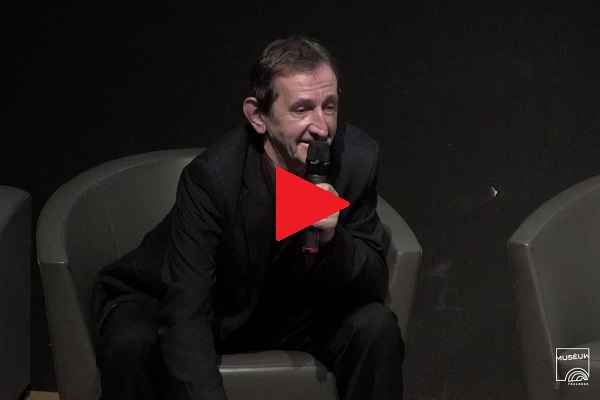
Konstantin Pozdniakov
Institut National des Langues et Civilisations Orientales, Paris
The Rongorongo Script
Abstract
Rongorongo is one of the independent writing systems and it is still undeciphered. The texts are carved on wooden tablets. The preferred wood for Rongorongo was fine-grained Pacific rosewood, once commonly found on the island (C.Orleac-M.Orleac). The driftwood and wood obtained from the European vessels were also occasionally used for the tablets. The texts are structured in the so-called “reversed boustrophedon” line arrangement – the first line is written from left to right, starting from the bottom left corner of the tablet, the second line is written upside-down above it, starting at the end of the previous line. Thus, each new line is rotated 180° relative to the previous one.
The discovery of Rongorongo dates back to the 1860’s, coinciding with the demographic catastrophe and massive slave raids that ravaged Easter Island. Hundreds of tablets disappeared. Today, only a small number of once numerous inscribed Rapa Nui artefacts survives – approximately two dozen artefacts with a total number of glyphs around 15,000. This is certainly not many but enough to get reliable statistics.
However, it is possible to perform reliable statistical analysis when there is a reliable catalogue of signs. The most known catalogue is that of Th.Barthel (1958). Barthel used three-digit numbers to encode 800 possible glyphs (638 of which are used). Digits of sign numbers record different glyph categories, and also the shape of hands, bodies and feet. The problem is that Barthel included not only singular signs but also hundreds of ligatures (sign combinations) in his catalogue. If we exclude these ligatures, we obtain only 60-70 signs (Pozdniakov). This drastically changes the results of statistical analysis, as well as our attitude to the type of the Rongorongo writing system.
To answer what type of writing system are we dealing with means to determine what is denoted by signs: words, syllables or sounds? The Rapanui language allows only open syllables formed by a consonant and a vowel or a vowel alone. With ten consonants and five vowels, the possible number of Rapanui syllables is 55. The number of separate signs in Rongorongo is too high to denote sounds and too small to denote words, while it is completely sufficient for representing every Rapanui syllable. More likely we are dealing with a mostly syllabic writing which can also include some determinatives (non-phonetic signs). A comparison of the statistical parameters of the Rongorongo signs, on the one hand, and the syllables of the Rapanui language, on the other, confirms this hypothesis. The texts feature a number of structural properties that look similar to the Rapanui language in syllabic notation (I.Pozdniakov-K.Pozdniakov 2007).
Another question is, what it the basis for the Rongorongo sign inventory? Boris Kudriavtsev, a young scholar from Leningrad, discovered important foundations for it. By the end of 1930’s he found that three known Rongorongo tablets record the same text (Kudriavtsev 1949). Subsequently, two other tablets bearing the same inscription were identified. On one hand, Kudriavtsev’s discovery "reduced" the number of surviving texts, but on the other, it offered a strong basis for further understanding of Rongorongo. Only by comparison of parallel texts could we for the first time identify significant and non-significant sign differences. Secondly, dozens of repeating fragments were discovered later by different scholars. These fragments are recurrent in different texts (or in the same text) but are structured in different orders. Today, it is clear that about one third of the corpus of Rongorongo consists of such repeated fragments of variable length (from 5 to 100 signs). Some texts (for example on tablets N, R, H/P/Q) consist more or less entirely of such sequences of signs. As soon as one sequence finishes, another one begins. Such texts represent a kind of a collection of numerous «mini texts» (Pozdniakov 1996).
Most scholars still use the hand-drawn copies published by Barthel. Today a new page has been opened in the paleographic study of Rongorongo. P.Horley almost finished his computer tracings of the entire corpus. All texts were traced with Paint.net 4.16 (dotPDN LLC). The tracings are made with four-node Bezier curves to achieve the required accuracy. Horley discovered that scribes made many corrections to the tablets, which means that they were concerned with accuracy of the texts they produced.
What do the Rongorongo signs look like? One could find: 1) anthropomorphic and zoomorphic signs (birds, marine creatures, lizards, turtles); 2) universal geometric motifs; 3) signs explicitly related to the environment and culture of Easter Island (floral elements, depictions of tools and personal adornments); 4) signs which are difficult to identify. A remarkable feature of Rongorongo is the use of five different signs depicting hands formed into various shapes, which are combined not only with anthropomorphic signs, but also with signs of birds, fish, as well as with signs depicting inanimate objects. According to my assumptions, these five hand signs correspond to the language’s five vowels. In my presentation, I aim to demonstrate and to discuss the Rongorongo iconography in detail.
In summary, the following scenario of the Rongorongo evolution can be assumed today. Eastern Polynesians populated Easter Island approximately in IX-X centuries – probably from Marquesas Islands. Even if they did not bring the writing system with them, they came with the idea of using carved symbols as an “external memory”. The high level of standardization of signs shows that the writing was developed during several centuries. The iconography of the texts suggests that the Rongorono writing system developed in full accordance with the general canons of local wooden art, elaborated by the inhabitants of Easter Island. Subsequently, the Rongorongo texts probably went through a phase of becoming sacred, as evidenced by the oral tradition. In the 19th century, it lost this status, and the skills to use it disappeared.
Images Related to the Talk
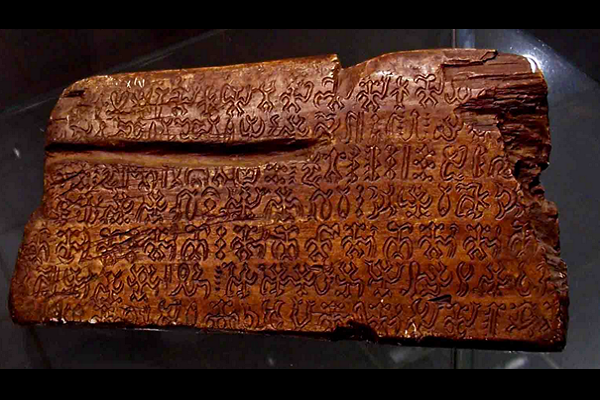
Tablet Echancrée
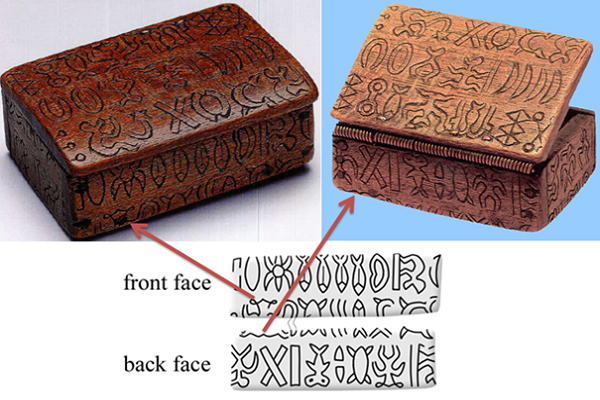
Paris snuffbox
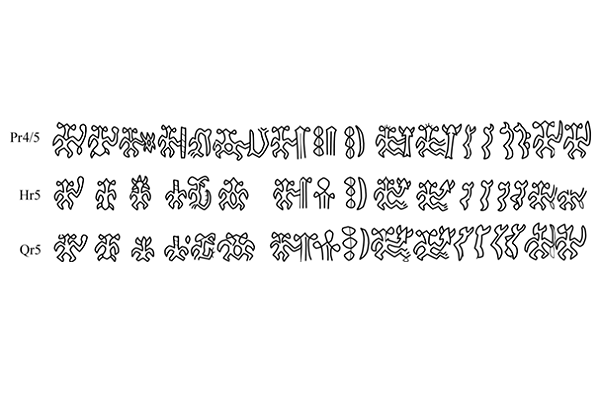
Parallel texts P/H/Q
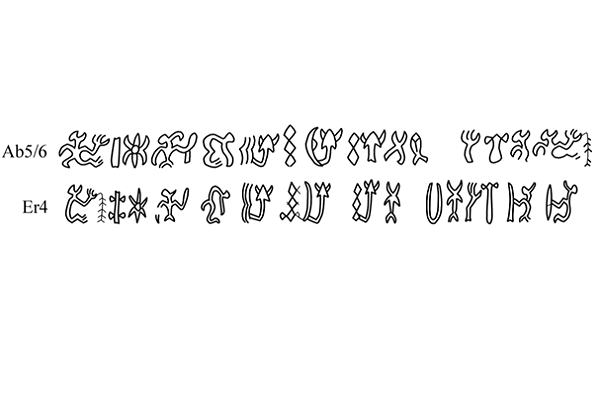
Parallel fragments
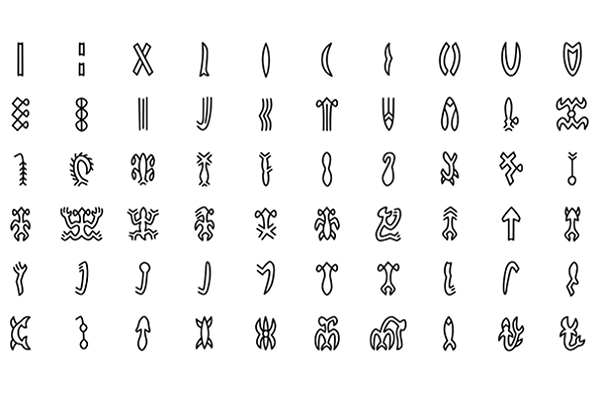
Basic signs of rongorongo


